Snowshoe hare tracks and White-tailed Jackrabbit tracks can be easily confused, as I am finding out. Size of their tracks, front and back overlap. Their stride and group length overlap. And even their habitat.
I’ve been doing a lot of research trying to discern the differences and what we have in my area. And its important because Snowshoes are the primary food for Lynx, a threatened and rare cat around here.
Its always good to take a hike around my mountain after a snowstorm. We’ve had a few inches of snow and some cold temps, making the snow almost perfect. The waxing gibbous moon insures more predators are out hunting, and with the snow crusted over, the smaller animals are out and about.
For weeks all I’ve seen are the usual suspects–deer and squirrels. But today was different. My first encounter was with weasel tracks. I’ve asked Jim Halfpenny if one can tell the difference between an ermine and a long-tailed weasel by the trail width. We have both here and Halfpenny notes that its very difficult. Tracks over 2″ trail width can often indicate a long-tailed weasel, but not for sure. The ‘dumbbell pattern’ of two dots [the feet], a dash [drag mark], and two dots can be typical for ermines, yet not always.
I have a bird feeder near the house and this weasel was taking advantage of the rodents that visit the dropped seeds.
I have been spending quite a bit of time trying to discern vole from mouse tracks. Most mouse tracks are quite obvious as they use a bound, with the back feet in front of the front. Voles tend to trot but I think they bound more in snow and have a much narrower trail width than a mouse. I’m still trying to discern the difference. I think these narrow tracks are typical vole tracks.
Higher up I ran into a Marten. And later on another Marten. Martens, like ermines, don’t use animal trails. They are explorers of every hole, seeking out rodents.
And here’s where we come back to the two hares. I came across these tracks, which look like typical Snowshoe hare tracks. Yet the country puzzled me. This hare, which I followed up the hillside for some ways, stayed in the small meadows between the forested areas, moving through the trees out of cover, rather than staying in cover like a Snowshoe would. And although this is Douglas Fir/Limber Pine territory, which Snowshoes like, most of the trees are older so the low browse is sparse. Yet according to this study conducted in Yellowstone National Park, White-tailed Jackrabbits are much rarer at my elevation and annual snow accumulations–though certainly not impossible. White-tailed jackrabbits are fairly rare in Yellowstone; even once erroneously thought extinct. Most of the Park has too much snow and too much tree cover. In fact, in the study, 3/4 of the few sightings were in the 5000-6000′ range in open sagebrush country [mostly all in the northwest corner of the park around Mammoth], while only 1/4 were in the 6-7000′ range in montane country–country akin to where I live.
I went over my measurements, yet all of them came up that it could be either a Snowshoe or a Jackrabbit. I remembered that at one point, Halfpenny had said to me “are you sure its not a Jackrabbit” when I described to him some prints I’d found in a deeply wooded area north of here.
I followed these tracks amongst the small forest meadows and down through an open area into the brush. I came to the uneasy conclusion that this must be a Jackrabbit.
And then I looked at a photo from last year, taken at around 6800′ deeper down my valley. I had my trail cam along an old ditch. On the upside of the ditch was dense woods, while the downside soon became treeless and led to a very large expanse of meadows. According to the Yellowstone study above, this was the upper end of White-tailed jackrabbits in the Yellowstone area [although White-tailed Jackrabbits have been reported in places like Colorado as high as 14,000 feet]. Here was my definitive answer that, yes, we have plenty of White-tailed Jackrabbits here.
Filed under: Tracking | Tagged: Ermine, marten, snowshoe hare, Weasel, White tailed jackrabbit, Yellowstone National Park Jackrabbits |















Leave a comment